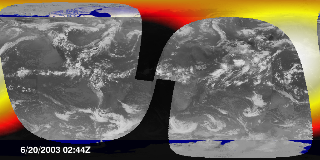|
|
 |
Incoming Solar Flux Compared to Clouds (WMS)
|
The Earth's climate is determined by energy transfer from the sun to the Earth's land, oceans, and atmosphere. As the Earth rotates, the sun lights up only part of the Earth at a time, and some of that incoming solar energy is reflected and some is absorbed, depending on type of area it lights. The amount of reflection and absorption is critical to the climate. An instrument named CERES orbits the Earth every 99 minutes and measures the reflected solar energy. This animation shows the incoming solar radiation within view of CERES during 29 orbits on June 20 and 21 of 2003. Because this is incoming solar flux, its magnitude only depends on the position of the sun, and, because the orbit is synchronized with the sun, the orbit crosses the equator in the daylight at about 1:30 PM local time on every orbit. This data is not actually measured from CERES, but is calculated to compare with the outgoing radiation that CERES does measure. Note that the infrared cloud image shown under the solar data shows high infrared as dark (land) and low infrared as light (clouds).
|
|

|
|
This animation shows incoming solar flux corresponding to 29 orbits (2 days) of CERES measurements, from June 20-21, 2003. This data is calculated using data from SORCE for the flux magnitude at the Earths orbit, coupled with solar incidence angles based on CERES measurement locations and times. The measurements are superimposed over a global infrared cloud cover composite from the same period.
Duration: 29.0 seconds
Available formats:
320x160
PNG
65 KB
160x80
PNG
19 KB
80x40
PNG
6 KB
640x320 (29.97 fps)
MPEG-1
5 MB
1024x512
Frames
How to play our movies
|
|
This product is available through our Web Map Service.
Click here to learn more.
|
|

|
|
This is the legend for the incoming solar flux animation, indicating the magnitudes of incident energy flux.
Available formats:
320 x 90
PNG
1 KB
|
|
|
Back to Top
|
|
|
|